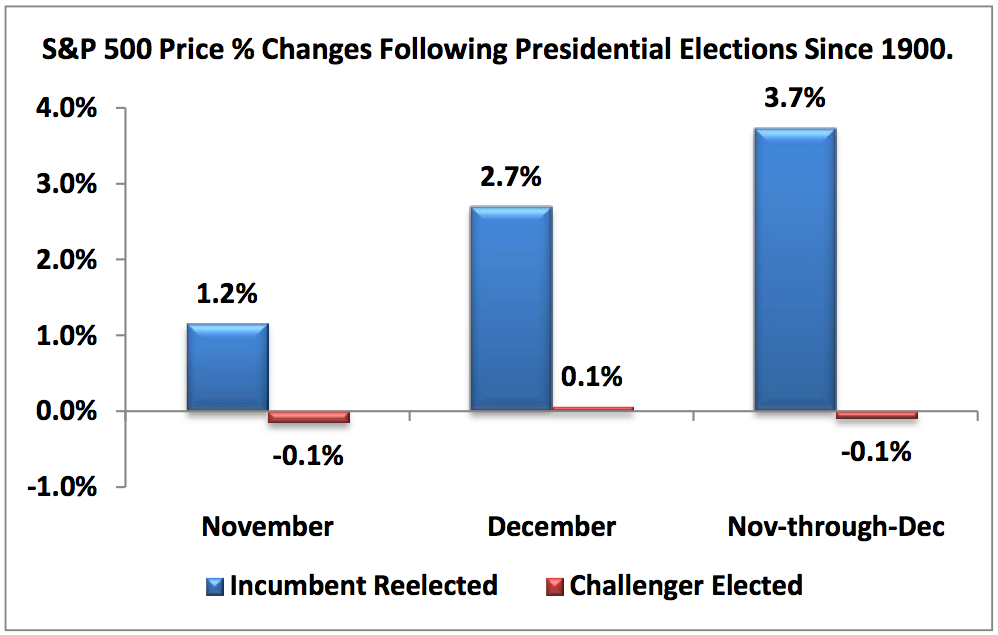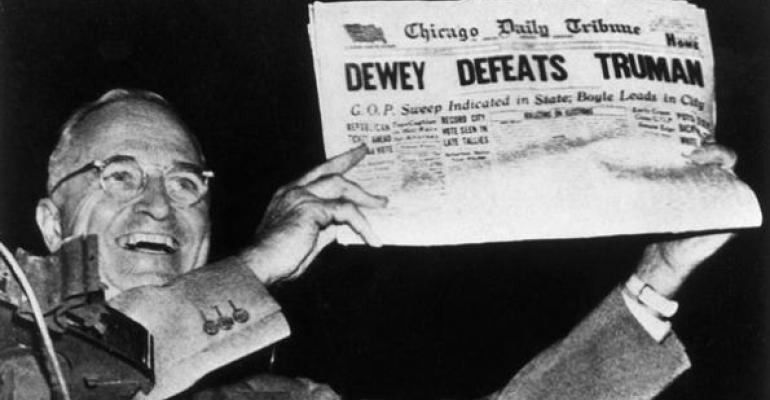We’ve all seen that iconic headline that appeared in the Chicago Tribune prematurely calling the election of 1948: “Dewey Defeats Truman.” Not a Nate Silver moment by any stretch of the imagination. As we all know, Truman took the presidency for his second term.
But the re-election of President Obama does have something in common with the election of Truman: The stock market’s not happy. And that’s a rarity following an incumbent’s re-election, said Sam Stovall, chief equity strategist for S&P Capital IQ. According to Stovall, the stock market was down 3.6 percent in the two-day period after Obama was elected. After Truman’s surprise re-election in Nov. 1948, the S&P 500 suffered an 11.7 percent sell-off through the end of the month.
But the Truman situation was an outlier. According to Stovall, the S&P 500 has traditionally advanced 1.2 percent in the November following an incumbent’s re-election, 2.7 percent in December and 3.7 percent in the November through December period. Why? My guess is it’s because investors know what they’re getting, to some extent. Meanwhile, the market typically fell during these periods following a victory by the challenger.
Here’s Stovall’s perspective:
The 1947-48 period has some striking similarities to the 2011-12 years. Both 1947 and 2011 were pre-election years in which the market ended the year almost exactly where it started. Cooperation between Congress and the President was rare, and the traditional third-year “priming of the economic pump” before the election was absent. As a result, 1947 and 2011 are the only pre-election years since 1900 that recorded 0.0% price changes, versus the more normal 11.1% gain, which is twice the average return for years 1, 2 and 4 of the presidential cycle. In 1948, the S&P 500 recorded a 9.2% year-to-date advance leading up to the election. After President Truman’s surprise reelection over the heavily favored challenger, Governor Thomas E. Dewey, the “500” suffered an 11.7% selloff through the end of the month. In 2012, the S&P 500 advanced 13.6% year to date through Election Day, on a projected 12-month improvement in the global economy and corporate earnings, and Wall Street‟s hoped-for replacement of a seemingly unpopular Democratic president or the swing to a Republican majority in the Senate. Wall Street got neither election outcome, so it took its ball and went home. Should the market experience a 1948-style response to this year‟s election outcome, the S&P 500 could fall to 1261, or only four points above where it started the year. In that case, let‟s just hope the historical comparison plays out, as the S&P 500 advanced 3.1% in December 1948 and 10.3% for all of 1949.While our base-case of economic, earnings, and technical outlooks doesn’t indicate that a market correction (a price decline of 10%-20%) is just around the corner, we acknowledge that the fallout from Hurricane Sandy, the erosion in EPS growth expectations and the political wrangling over the fiscal cliff in Washington cannot eliminate such a reaction from the realm of possibility.





